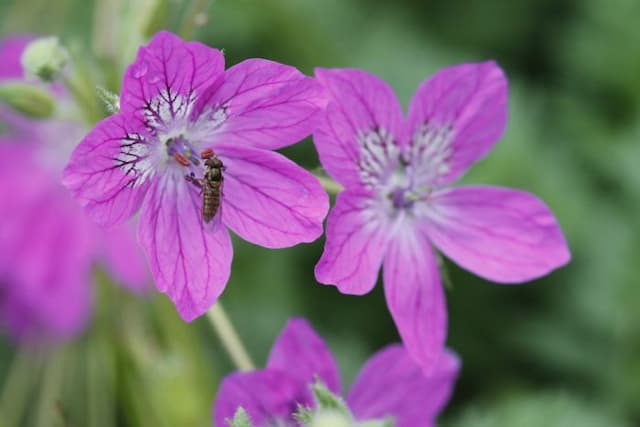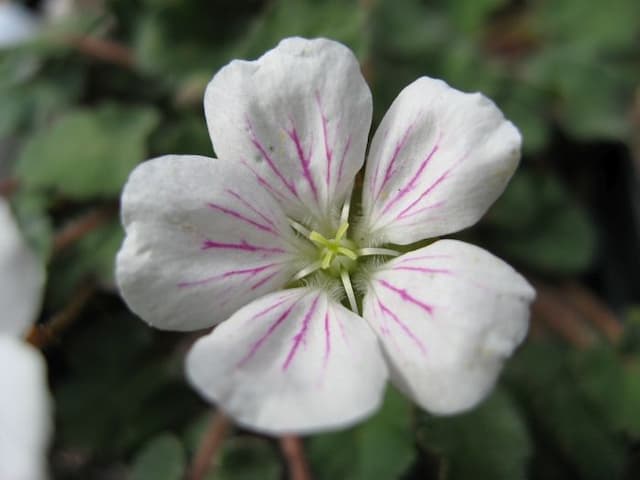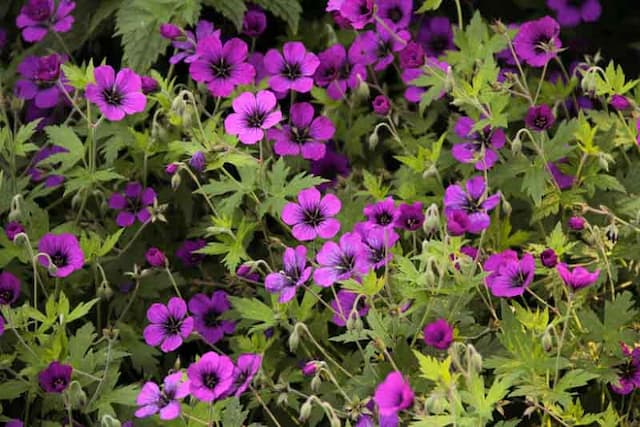Cranesbill 'Azure Rush' Geranium 'Azure Rush'

ABOUT
'Azure Rush' is a more compact perennial, than it's well-known parent, 'Rozanne'. With light, lavender-blue flowers it has a long flowering period from early summer to autumn
About this plant
 Names
NamesFamily
Geraniaceae
Synonyms
Azure Rush Cranesbill, Azure Rush Geranium
Common names
Geranium 'Azure Rush'
 Characteristics
CharacteristicsLife cycle
Perennials
Foliage type
Deciduous
Color of leaves
Green
Flower color
Blue
Height
1-2 feet (30-60 cm)
Spread
2-3 feet (60-90 cm)
Plant type
Herb
Hardiness zones
5
Native area
Non-native hybrid
Benefits
 General Benefits
General Benefits- Attracts Pollinators: 'Azure Rush' Geranium is known to attract bees and butterflies, which are beneficial for pollination in the garden.
- Low Maintenance: It requires minimal care once established, making it a convenient choice for gardeners of all levels.
- Drought Tolerant: Once established, it can tolerate periods of dryness, reducing the need for frequent watering.
- Long Blooming Season: It flowers from late spring to early fall, providing a long season of visual interest.
- Versatile Planting Options: This Geranium can be used in borders, containers, or as a ground cover, offering flexibility in garden design.
- Rabbit Resistant: It's typically resistant to damage from rabbits, which can be beneficial in areas where wildlife browsing is a problem.
- Colorful Foliage: In addition to its flowers, 'Azure Rush' has attractive foliage that adds depth and texture to the garden even when not in bloom.
- Compact Growth Habit: Its mounding habit makes it suitable for small gardens or spaces where plants need to be kept under control.
 Medical Properties
Medical PropertiesThis plant is not used for medical purposes.
 Air-purifying Qualities
Air-purifying QualitiesThis plant is not specifically known for air purifying qualities.
 Other Uses
Other Uses- Geraniums' bright petals can be used to add a splash of color to salads and desserts, as an edible garnish that is safe if properly cleaned.
- The leaves of the Geranium can be infused into oils and used for aromatherapy, providing a light floral scent that can promote relaxation.
- The dried flowers and leaves can be used in potpourri mixes to freshen up the smell in homes without using synthetic fragrances.
- Geranium can be planted as a companion plant in the vegetable garden; its strong scent is said to repel certain pests like cabbage worms.
- The plant can be made into a natural dye for fabrics or paper, producing a range of colors from green to brown, depending on the mordant used.
- Pressed Geranium flowers can be used in crafting, such as for making bookmarks, greeting cards, or in scrapbooking for natural embellishments.
- Geranium leaves can be rubbed onto wooden furniture as a natural polish and to give a pleasant scent to the wood.
- These plants are often used in horticultural therapy, providing both an activity and a sensory stimulation for therapeutic benefits in various care settings.
- Geranium petals can be frozen in ice cubes to create visually appealing and edible additions to cold beverages during summer gatherings.
- Photographers and artists sometimes utilize the Geranium's appealing aesthetic for still-life compositions, studying its form and color for artistic inspiration.
Interesting Facts
 Feng Shui
Feng ShuiThe plant Geranium is not used in Feng Shui practice.
 Zodiac Sign Compitability
Zodiac Sign CompitabilityThe plant Geranium is not used in astrology practice.
 Plant Symbolism
Plant Symbolism- Friendship: Geraniums are often associated with positive emotions and bonds between people, symbolizing the importance of friendship and maintaining close relationships.
- Health and Good Luck: The geranium is sometimes believed to bring good luck and promote health, making it a common gift for those who are ill or facing challenges.
- Harmony and Peace: With its pleasant fragrance and attractive blooms, the geranium can symbolize a desire for peace and harmony in one's life or in relationships.
- Folly or Stupidity: In some Victorian-era language of flowers, geraniums could represent folly or foolishness, albeit this interpretation is less common today.
- True Geranium (Cranesbill): Note that ‘Azure Rush’ is a type of Cranesbill geranium, which may share these common symbolic meanings, albeit with their unique charm and characteristics.
 Water
WaterThe Geranium 'Azure Rush', commonly known as Cranesbill, should be watered deeply once the top inch of soil feels dry to the touch, approximately every week during active growth periods depending on climate conditions. The amount of water this plant requires can vary, but a general guideline is to provide about 1 gallon of water per plant each watering session to ensure the soil is moistened well. During the winter or dormant phase, reduce watering to every other week, ensuring the soil does not completely dry out, but also making sure the plant is not sitting in waterlogged soil.
 Light
LightCranesbill thrives in conditions where it can receive full sun to partial shade. The best spot for this plant would be in a garden bed or container that gets at least 4 to 6 hours of sunlight a day. However, in hotter climates, protection from the intense afternoon sun can help prevent scorching, making dappled shade an ideal location for the afternoon hours.
 Temperature
TemperatureCranesbill prefers a temperature range between 65°F and 75°F for optimal growth. It can withstand minimum temperatures down to about 30°F, but should be protected from frost. During the summer months, the plant can survive higher temperatures as long as appropriate watering and shade during peak sun hours are provided.
 Pruning
PruningPruning Cranesbill helps to maintain a compact shape, encourage bushier growth, and promote more vibrant flowering. Cut back the foliage by about one-third after the first bloom in midsummer to rejuvenate the plant and encourage a second bloom period. Deadheading, or removing spent flowers, can be done regularly to keep the plant tidy and direct energy towards producing new flowers.
 Cleaning
CleaningAs needed
 Soil
SoilThe best soil mix for a Cranesbill (Geranium 'Azure Rush') should be well-draining with added organic matter such as compost or peat moss. A soil pH of 5.8 to 6.3 is optimal for this plant, ensuring it has the right balance of acidity for nutrient uptake.
 Repotting
RepottingCranesbill should be repotted every 2-3 years to replenish its soil and to accommodate root growth. It's best done in the early spring before new growth starts.
 Humidity & Misting
Humidity & MistingCranesbills thrive in average humidity levels but are adaptable to drier conditions; however, avoiding excessively dry air is beneficial for the plant's health and bloom.
 Suitable locations
Suitable locationsIndoor
Ensure bright light, well-draining soil, and regular watering.
Outdoor
Plant in part sun, enrich soil, water regularly, protect from frost.
Hardiness zone
4-8 USDA
 Life cycle
Life cycleGeranium 'Azure Rush', a perennial plant, begins its life cycle as a seed, which germinates in moist, well-draining soil with adequate warmth. The seedling emerges with its first set of true leaves, after which it will go through a period of vegetative growth, developing a robust root system and foliage. As the plant matures, it enters the flowering stage, characterized by the production of its notable blue flowers, which is a critical phase for its reproduction. Following pollination, seeds are produced and dispersed, allowing the life cycle to continue. During the fall, as temperatures drop, Geranium 'Azure Rush' may die back, entering a dormancy stage where above-ground growth ceases, while the root systems remain active. With the return of warmer spring temperatures, the plant resumes growth, completes its life cycle, and begins anew.
 Propogation
PropogationPropogation time
Spring-Early Summer
Propogation: Geranium 'Azure Rush', known commonly as cranesbill or hardy geranium, is often propagated by division, a method where the gardener separates an existing plant into several smaller pieces, each with its own root system. The best time to propagate by division is in the spring or early fall when the plant is not in full bloom and energy can be directed towards root and foliage development. To divide a cranesbill, carefully dig up the plant and gently tease apart the root ball into smaller sections, ensuring that each new section has a healthy amount of roots and shoots. These new plants can then be immediately replanted in the garden, spaced at least a foot (30 cm) apart to allow room for growth. Water the new divisions thoroughly after planting to help establish them. Division is an efficient way to create more plants and also rejuvenate older plants that might have a dead or woody center.









![Cranesbill [Rothbury Gem]](/_next/image?url=https%3A%2F%2Fplants-admin.emdemapps.com%2Fimages%2Fplants%2F%2Fimages%2F604b6243984c2.png&w=640&q=75)